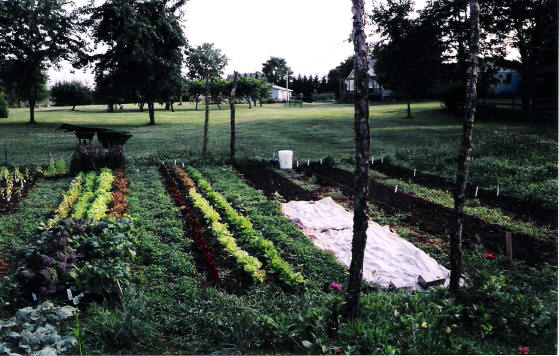Not only will you grow delicious, fresh, healthy foods; you will also contribute to the health of the environment and community by not using harmful chemicals. But organic gardening doesn't just mean not using chemicals. It is a method that
encourages life and diversity in the soil, plants, and insects that live in the garden.

The component that puts the 'organic' in organic gardening is organic material (OM). This is the stuff that was once alive and, with the help of beneficial bacteria, is now decomposing in your garden. For a great garden, you want as much of this
decomposed matter as possible.
Addition of OM. If you are ambitious this time of year you can start putting OM into your garden now. Put a thin layer of dead leaves, straw, hay, or grass clipping on your garden right away. It will break down, and when it is time to start planting
you will have already incorporated some ever-so-important OM into your soil.
Compost. A key component to organic gardening is compost. Incorporate a fair amount (up to a 1 inch layer) of compost to your beds before planting. Leafgro™ is available at local garden centers, as well as other brands. Free compost is available from
the county recycling centers in both Frederick and Carroll Counties. Learn about composting techniques and make your own pile and by this time next year you may not have to buy any.
Organic Seeds. If you usually start your own plants, you can buy organically grown seeds (sources below). This seed has been grown in compliance with the USDA organic program. With this seed you can be sure that you are supporting non-genetically
engineered, sustainable production techniques.
Heirloom varieties are often chosen in organic gardens. Heirlooms are open-pollinated varieties that have been preserved for many generations. These plants will produce seed that will grow a plant genetically identical to the parent. This way you can
save your seed from year to year and know what will result and at the same time preserve the diversity of unique varieties.
Weed Control. During the year, to discourage weeds, use mulch. Thick layers of the organic materials that I mentioned before will prohibit weed seed germination, as well as break down and add organic matter to the soil. You may also use synthetic
mulches such as weed barrier fabric or black plastic (but make sure you remove plastic at the season's end). Lay these over your garden beds and secure with soil at the edges. Cut holes and plant into them; this will greatly reduce weed pressure.
Pest Management. This can be challenging in organic gardening. It is said that when your soil is of high quality (containing lots of organic matter and nutrients), your plants will resist pests naturally. It takes a long time for soil to achieve this
status. In the mean time, plant lots of flowering plants to encourage beneficial insects, which prey on pests. A few examples of these plants are yarrow, sea holly, allysum, dill and tansy. Another great weapon against pests is row cover. This thin, water and light
permeable synthetic fabric provides a physical barrier between your plants and pests.
Cover Crops. One additional method that you may want to experiment with is cover crops. A good rule is to always keep your soil covered. If you grow a nice spring crop of lettuce and don't have anything to put in when it is finished producing in
July, grow some soil nourishing crops like buckwheat rather than leaving your soil bare. You can mow or cut it down before it produces seed and let the plant matter decompose into the soil, adding organic matter along the way. There are endless variations on cover cropping
techniques.
Are Your Lawn Care Products Harming Your Cat?
Read other articles on plants and gardens
Read other articles on ecological gardening & native plants